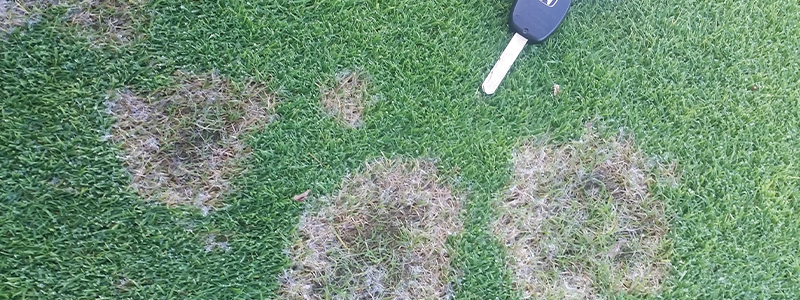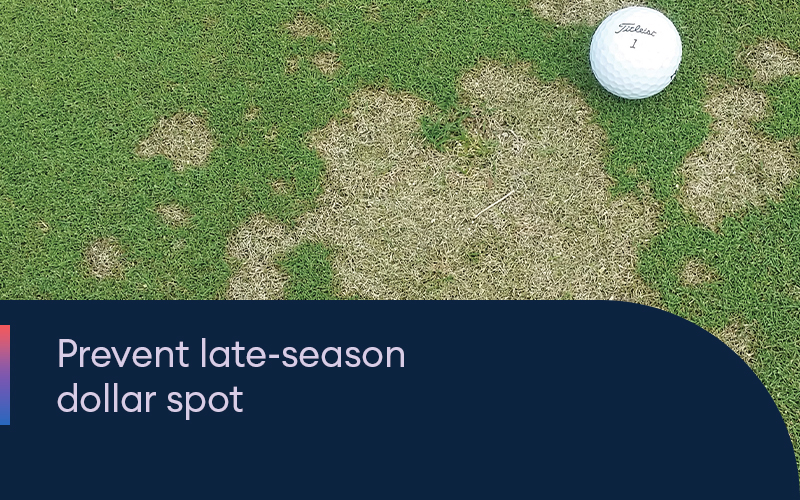Look at the numbers to prevent late-season dollar spot
Whether late-season dollar spot is active or not comes down to what weather conditions we experience during the end of summer heading into fall.
When high humidity is present (>65% relative humidity), daytime temperatures are between 21°C and 26°C, with cool nights above 16 °C, you can be sure that late-season dollar spot can become active on your course. As summer continues to hang on, those warmer days can allow dollar spot to remain active on days where temperatures approach 30°C.
The disease tends to be most severe with warm days, cool nights, low soil moisture but long dew periods, daily ground fogs that extend leaf wetness periods, and low nitrogen fertility. At night, relative humidity rises and the winds begin to calm. Dollar spot takes advantage of favourable conditions as nights get longer as the summer progresses into fall.
The Smith-Kerns Dollar Spot Model uses a 5-day moving average of daily relative humidity and daily average air temperature to estimate the probability that dollar spot will occur on a given day. For much of the summer, the Smith-Kerns model has calculated dollar spot probabilities over 40% in many areas throughout Canada.
Golf superintendents sometimes take a “wait-and-see” approach to see if dollar spot shows up on the course before deciding to apply a fungicide to control the disease. Unfortunately, if temperature and humidity are in the right range during the summer to fall transition, dollar spot infection could be happening inside plants before you see symptoms and outbreaks of the disease can become difficult to control late in the season.
Adhere carefully to fungicide reapplication intervals when conditions are right for late-season dollar spot to emerge. Any lapse in interval timing and late-season dollar spot is bound to show up. Utilize the Smith-Kerns model as a tool to understand what level of dollar spot pressure your course is under. Under periods of highest pressure, it is important to use higher rates and shorter intervals to protect your turf from disease outbreaks.

Leaving turf unprotected at this critical time of year can leave you behind the eight ball if turf is not able to recover from disease going into winter months. Late-season dollar spot outbreaks that do not fill in before winter can leave unsightly pockmarks in the turf that can affect playability when the course emerges the following spring.
Fungicides are a key part of an integrated dollar spot management program. Since dollar spot is a foliar disease, select spray nozzles and spray volumes that provide good coverage to maximize fungicide activity. Integrating cultural and chemical control strategies provides the most effective control of this fungal disease.
There are some cultural practices that you can employ along with regular fungicide applications:
- Maintain adequate nitrogen when dollar spot is active
- Make light, frequent nitrogen applications, avoiding drought stress
- Remove dew by mowing, poling, or rolling
- Methods to reduce compaction and thatch when disease is not active
- Remove trees or add fans to increase air circulation
Envu Fungicide program
Mirage® Stressgard® provides broad-spectrum control of important diseases with a proven active ingredient for dollar spot control, tebuconazole. It’s a great product in summer-to-fall disease prevention programs to control dollar spot and other late summer diseases.
Exteris® Stressgard® is formulated with a novel SDHI active ingredient, fluopyram, combined with trifloxystrobin to provide long-lasting preventative and curative control of foliar turf diseases including dollar spot, anthracnose, brown patch and leaf spot. It provides preventative and fast curative dollar spot control on fairways from 14-28 days.
For more information about dollar spot, download the solution sheet or contact your local Territory Sales Manager for dollar spot control strategies specific to your needs.
ALWAYS READ AND FOLLOW PESTICIDE LABEL DIRECTIONS. Envu, the Envu logo, Mirage® Stressgard® and Exteris® Stressgard® are trademarks owned by Environmental Science U.S. LLC. or one of its affiliates. ©2023 Environmental Science U.S. LLC. All rights reserved.

